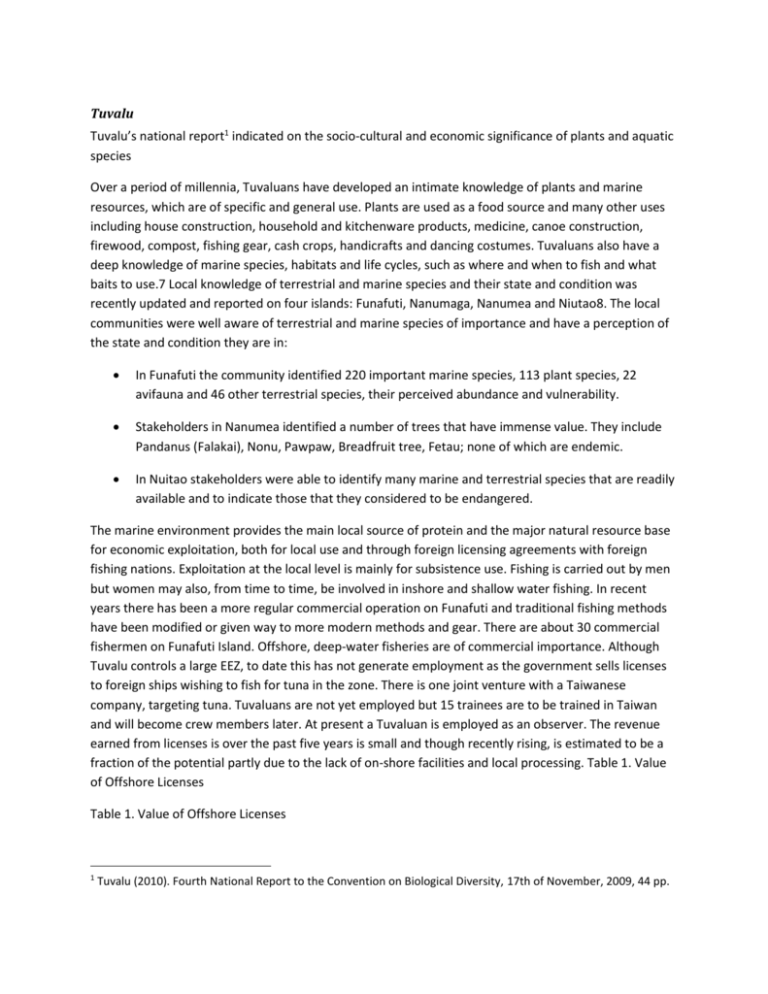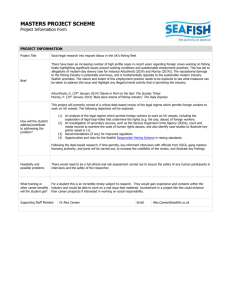Tuvalu - Convention on Biological Diversity
advertisement

Tuvalu Tuvalu’s national report1 indicated on the socio-cultural and economic significance of plants and aquatic species Over a period of millennia, Tuvaluans have developed an intimate knowledge of plants and marine resources, which are of specific and general use. Plants are used as a food source and many other uses including house construction, household and kitchenware products, medicine, canoe construction, firewood, compost, fishing gear, cash crops, handicrafts and dancing costumes. Tuvaluans also have a deep knowledge of marine species, habitats and life cycles, such as where and when to fish and what baits to use.7 Local knowledge of terrestrial and marine species and their state and condition was recently updated and reported on four islands: Funafuti, Nanumaga, Nanumea and Niutao8. The local communities were well aware of terrestrial and marine species of importance and have a perception of the state and condition they are in: In Funafuti the community identified 220 important marine species, 113 plant species, 22 avifauna and 46 other terrestrial species, their perceived abundance and vulnerability. Stakeholders in Nanumea identified a number of trees that have immense value. They include Pandanus (Falakai), Nonu, Pawpaw, Breadfruit tree, Fetau; none of which are endemic. In Nuitao stakeholders were able to identify many marine and terrestrial species that are readily available and to indicate those that they considered to be endangered. The marine environment provides the main local source of protein and the major natural resource base for economic exploitation, both for local use and through foreign licensing agreements with foreign fishing nations. Exploitation at the local level is mainly for subsistence use. Fishing is carried out by men but women may also, from time to time, be involved in inshore and shallow water fishing. In recent years there has been a more regular commercial operation on Funafuti and traditional fishing methods have been modified or given way to more modern methods and gear. There are about 30 commercial fishermen on Funafuti Island. Offshore, deep-water fisheries are of commercial importance. Although Tuvalu controls a large EEZ, to date this has not generate employment as the government sells licenses to foreign ships wishing to fish for tuna in the zone. There is one joint venture with a Taiwanese company, targeting tuna. Tuvaluans are not yet employed but 15 trainees are to be trained in Taiwan and will become crew members later. At present a Tuvaluan is employed as an observer. The revenue earned from licenses is over the past five years is small and though recently rising, is estimated to be a fraction of the potential partly due to the lack of on-shore facilities and local processing. Table 1. Value of Offshore Licenses Table 1. Value of Offshore Licenses 1 Tuvalu (2010). Fourth National Report to the Convention on Biological Diversity, 17th of November, 2009, 44 pp. Calendar year A$ millions 2004 4.178 2005 3.055 2006 5.433 2007 4.527 2008 8.863 Source: Offshore Fisheries Surveillance, Funafuti Generally in the Pacific, management of EEZs has been fraught with problems associated with weak control and the migratory nature of the main species, tuna. Many distant water fishing fleets, both licensed and unlicensed, exploit the lack of enforcement capabilities in the region and engage in illegal, unreported and unregulated fishing, including fishing without licenses, falsely reporting catches, illegally trans-shipping catches and avoiding vessel monitoring systems. Tuvalu has one patrol boat. A monthly air patrol is carried out by the RNZAF. The effect of deleterious fishing activities on the high seas to inshore waters has not been documented. Other actions on the high seas by passing vessels, such as oil spill and the dumping waste pose a threat. They are not monitored. Already, the exchange of ballast water in or near the Funafuti lagoon has introduced invasive species, such as the crown of thorns, which has spread to other lagoons, at Nukufetau and Nukulaelae, and Vaitupu. --- 2






